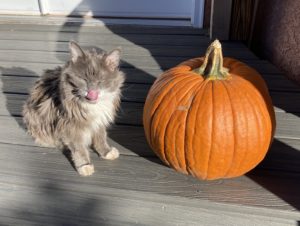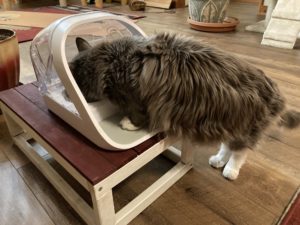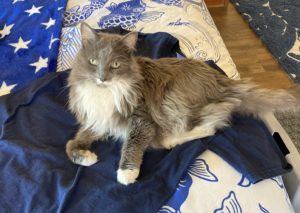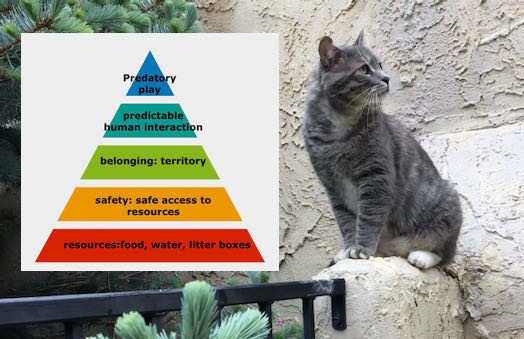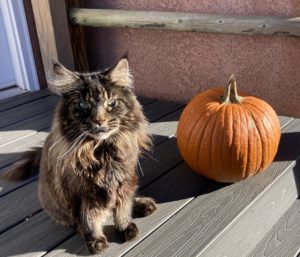
It’s that spooky time of year where black cats and pumpkins are all the rage. But did you know that many cats dine on pumpkin year round? Why add pumpkin to your cat’s diet? Does it work?
pumpkin and cats
Pumpkin is a popular way to add fiber to a cat’s diet. Fiber can be used to manage diarrhea, constipation, diabetes, satiety, and hairballs.
Fresh pumpkin is said to have about 3 g of dietary fiber per cup while canned pumpkin can have up to 7 grams per cup.
What is fiber?
The story about fiber is complex so I will just say that fiber is substances in food that cannot be digested by the enzymes in the small intestines. Fiber arrives in the large intestine undigested and unchanged.
Fiber can be soluble in water or not (insoluble).
Soluble fibers
- Some soluble fibers form a gel in the intestines that slows digestion of carbohydrates, keeping blood sugar levels steady.
- This gel may also block fat that would otherwise be digested.
- Other soluble fibers ferment in the large intestine, forming the short chain fatty acids (SCFA) that are part of the cross-talk between the intestinal microbiome and the brain.
Insoluble fibers can pass through the GI tract intact and function to “bulk up” stool and help waste move through the gut.
THE TAKEWAY: It important to have the right amount of the right type of fiber.
- Too much fermentable fiber can result in excess gas and gastrointestinal discomfort.
- not enough insoluble fiber may result in diarrhea.
Fiber and carnivores
We tend to think of plants when talking about fiber. But our cats are obligate carnivores, meaning they mainly eat meat. Do they need fiber?
“animal fiber”
A wild cat will eat the entire mouse – fur, bone, cartilage, gut content, tendons, ligaments. These indigestible parts act as fiber – bulking up stool and helping waste pass through the intestines. Even the chitin in the wings of that grasshopper can function as fiber. Some of these materials ferment in the large intestine forming SCFA that allow the microbiome in the gut to talk to the brain.
A study looking at “animal fiber” compared a diet of whole rabbits (fur and all) versus supplemented beef for captive cheetahs. The cheetahs eating the whole rabbits had more SCFA in their stool than those cheetahs eating supplemented beef. The stools of the rabbit-fed cheetahs were also bulkier due to the “animal fiber”.
We don’t feed our cats whole rabbits – plant fiber is more easily sourced so commercial cat food includes these. Research has shown that feeding our cats moderate amounts of fermentable fiber such as beet pulp helps feed the intestinal microbiome without a lot of gas and bulky stool.
Back to Pumpkin and cats…
Pumpkin has both soluble and insoluble fiber. One tablespoon of canned pumpkin contains about 0.1 g of soluble fiber and 0.4 g of insoluble fiber. By comparison, 1 teaspoon of metamucil ( psyllium) provides 10 times as much fiber: 2 grams of soluble fiber and 3 grams of soluble fiber.
While pumpkin is safe for most cats, you may have to give a lot of pumpkin to match the level of fiber in say, one of the veterinary therapeutic diets. There are no real guidelines to supplementing fiber in commercial cat diets so talk to your vet if you feel that your cat needs fiber to manage diarrhea, constipation, or hairballs. Your vet can recommend a diet or supplement with the appropriate type and amount of fiber.
If you decide to supplement your cat’s diet with pumpkin, be sure to choose canned pumpkin and not pumpkin pie mix. While pumpkin and cats are a safe combination, the sugar and spices in pumpkin pie mix are not good for your kitty.
The nutritionists at Cummings Veterinary Medical Center (Tufts University) recommend that …“If supplemented, fiber should always be given gradually over a few days to weeks until the stool reaches the desired composition or other desired benefit is reached (or it becomes clear that it is not helping).”
Happy Halloween!